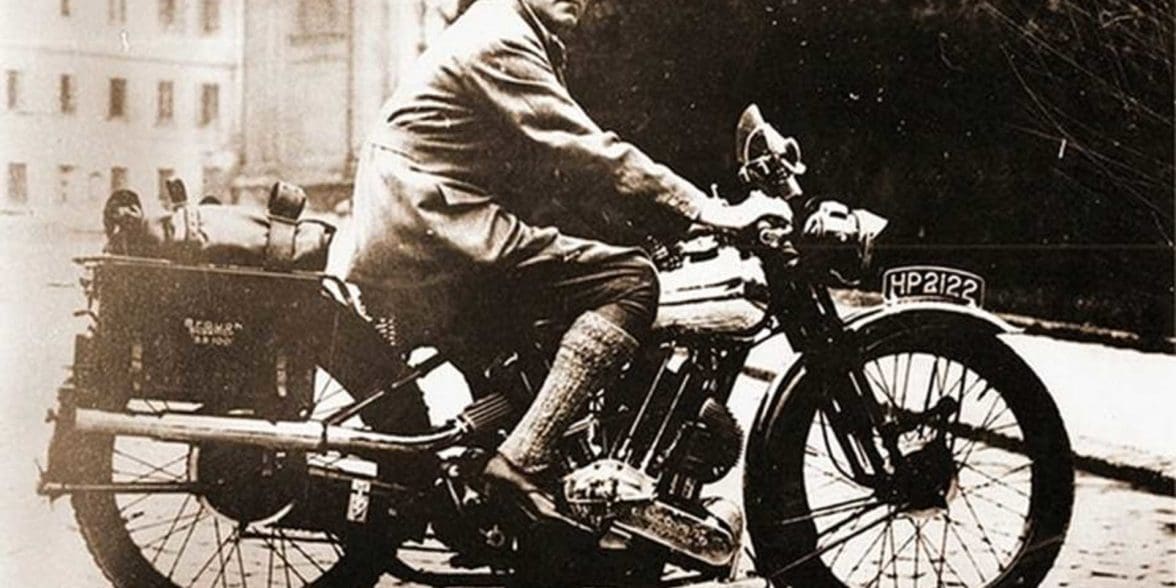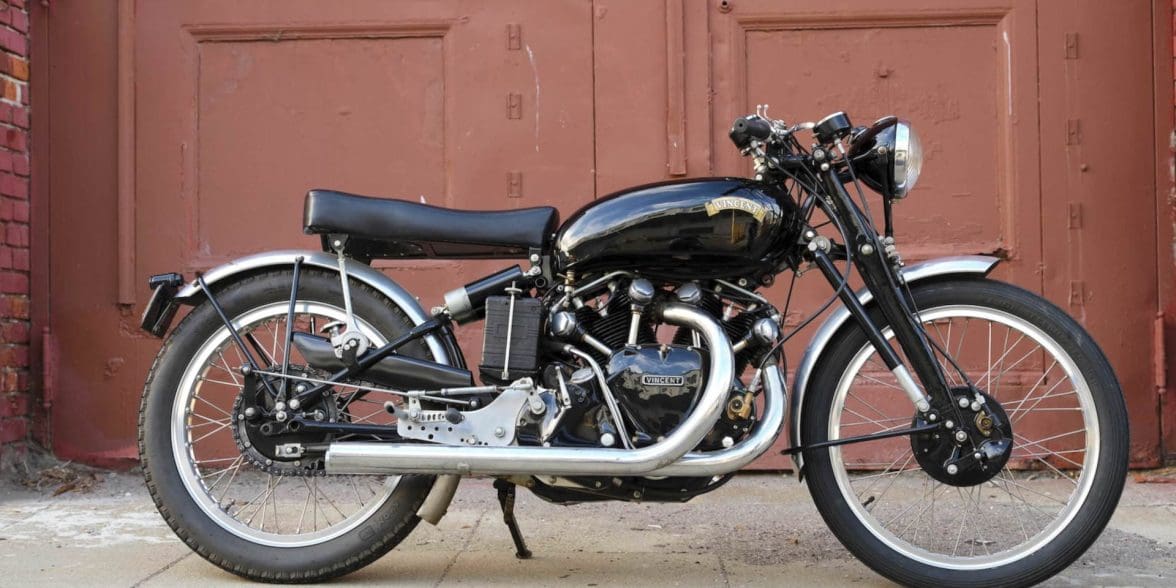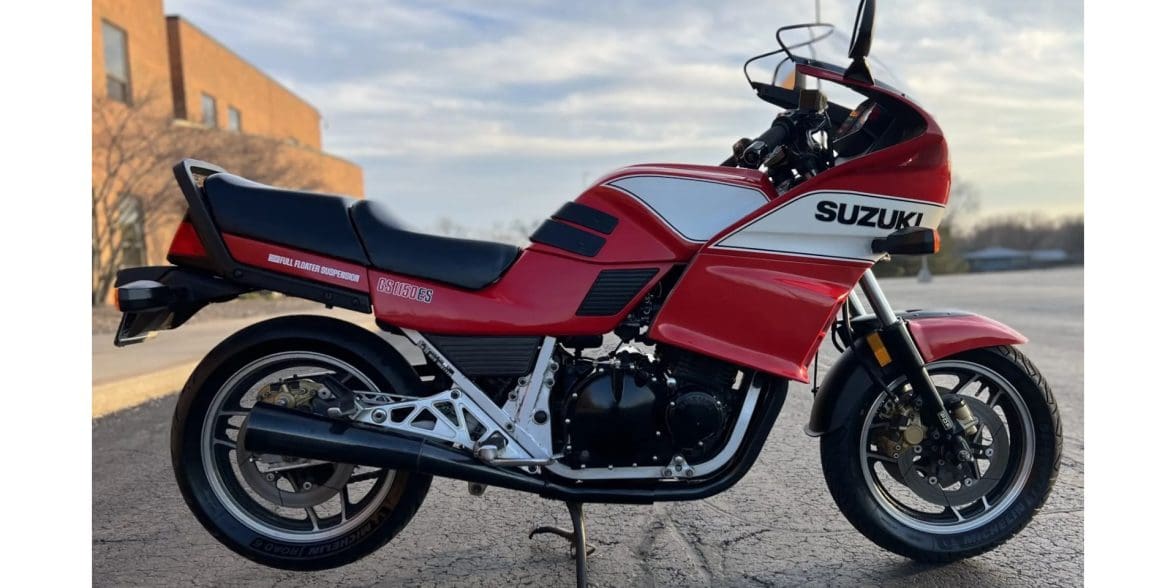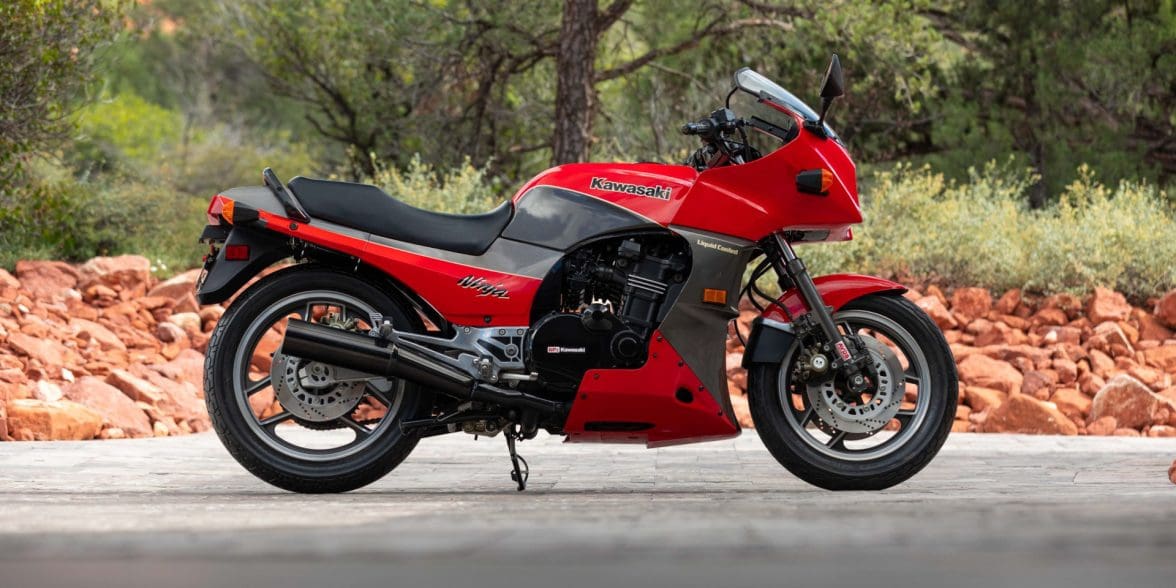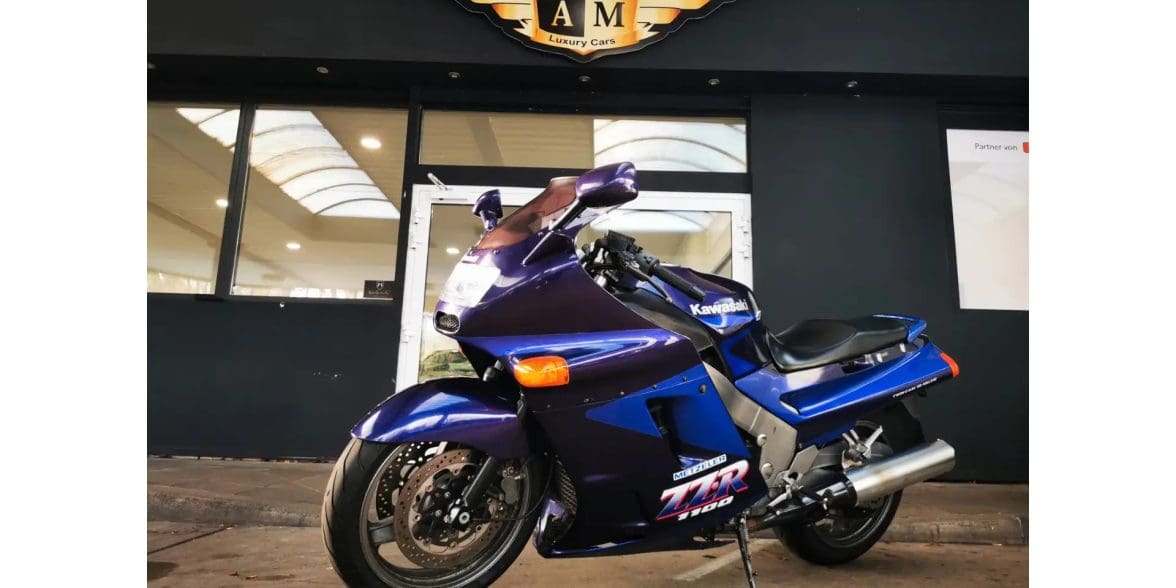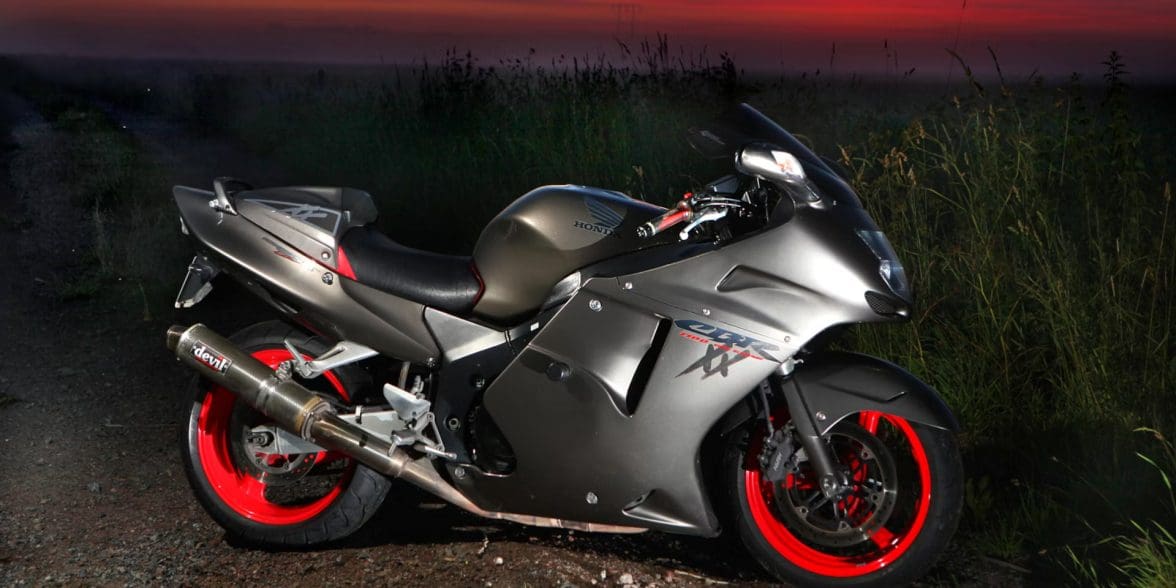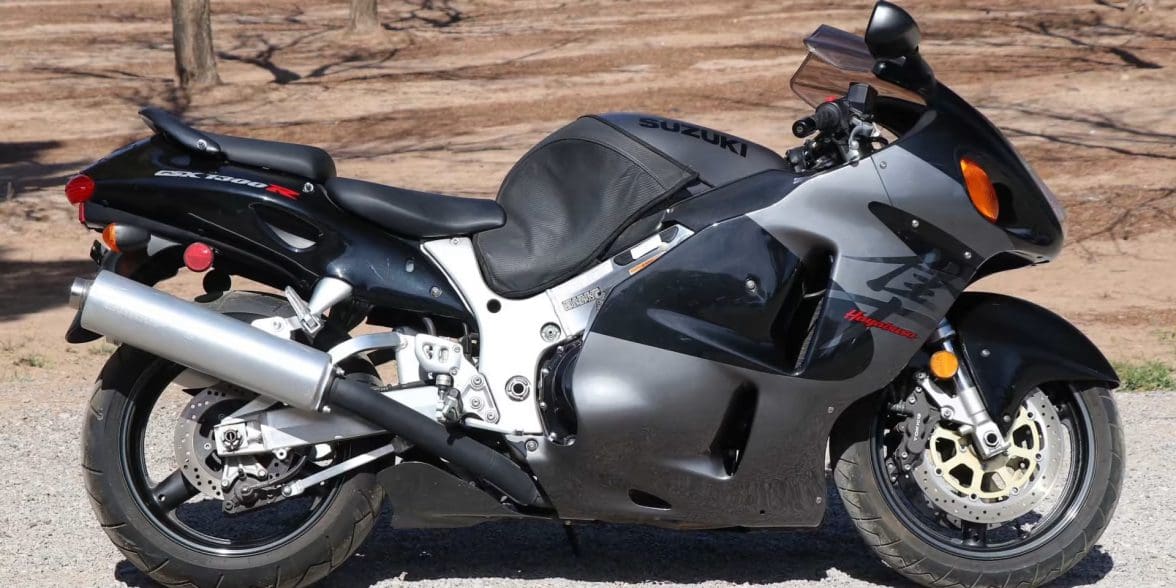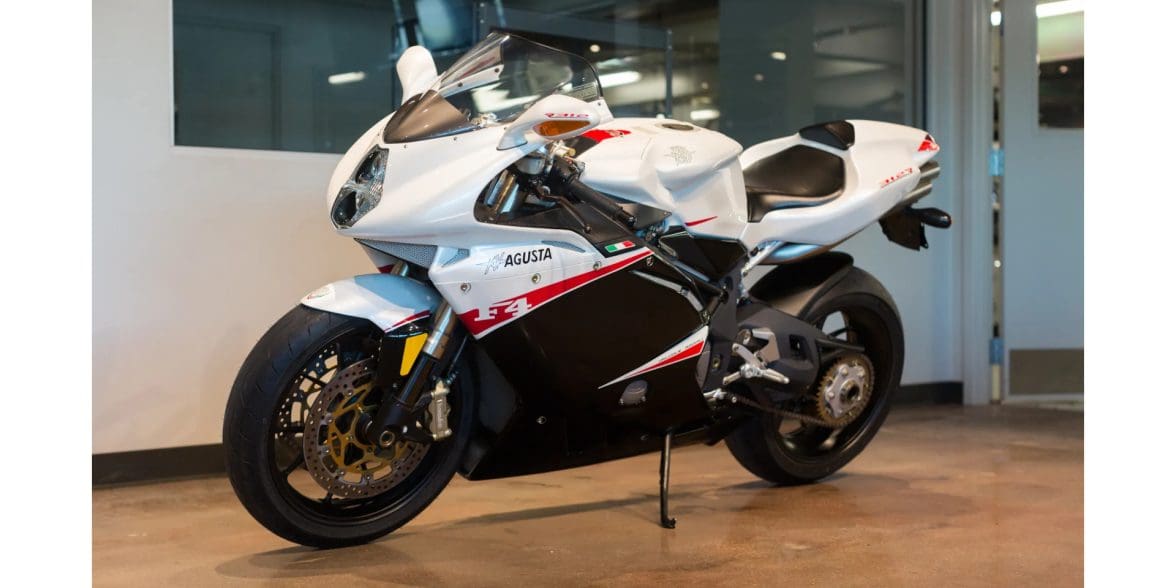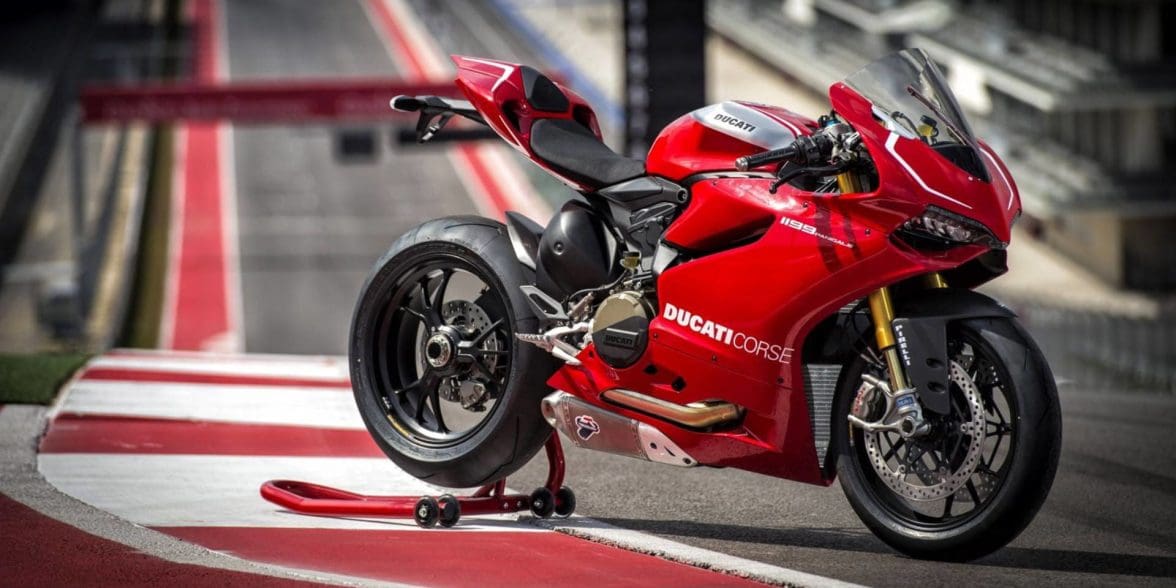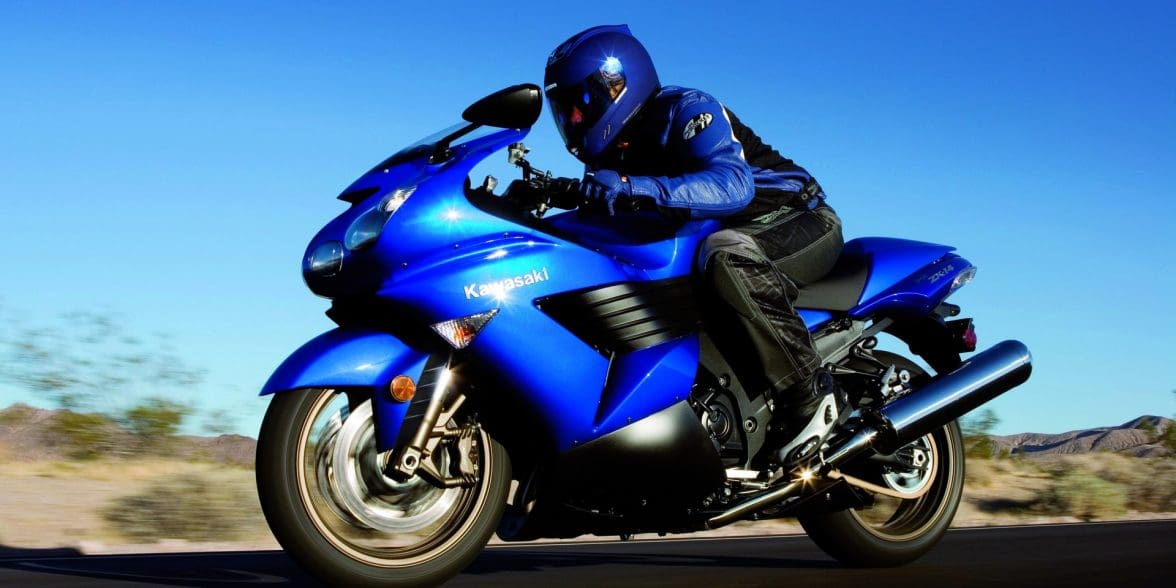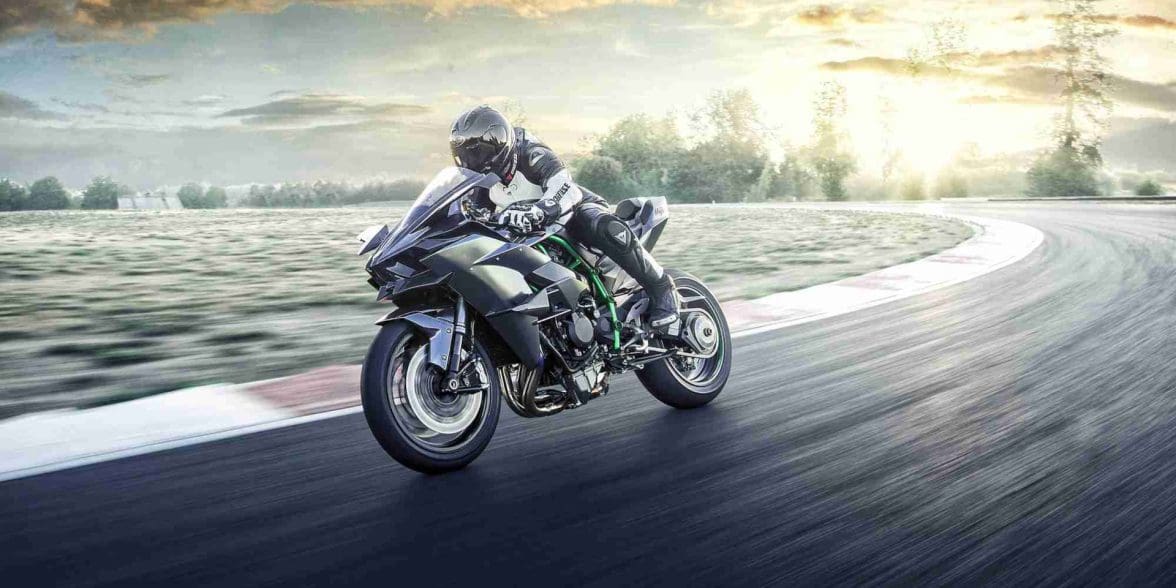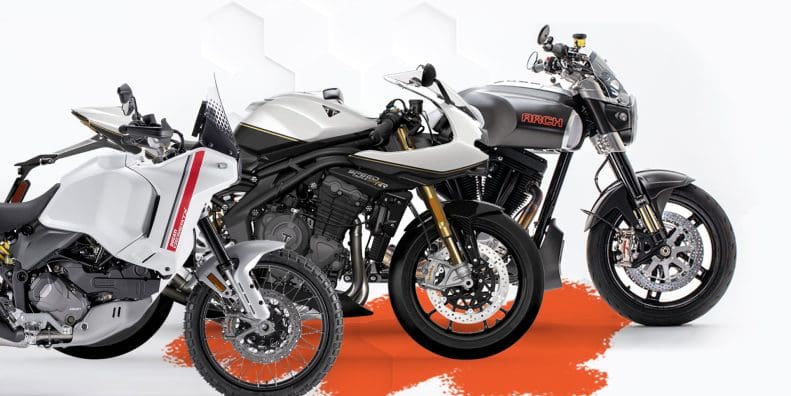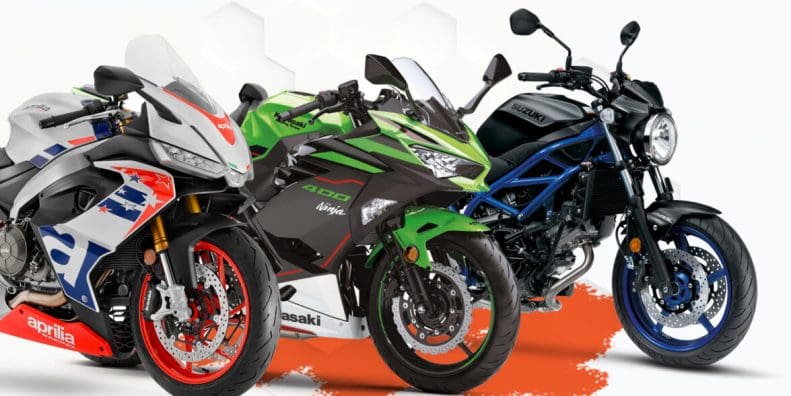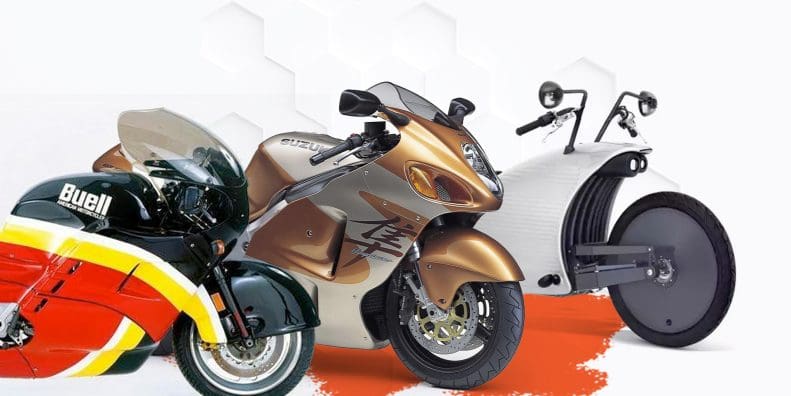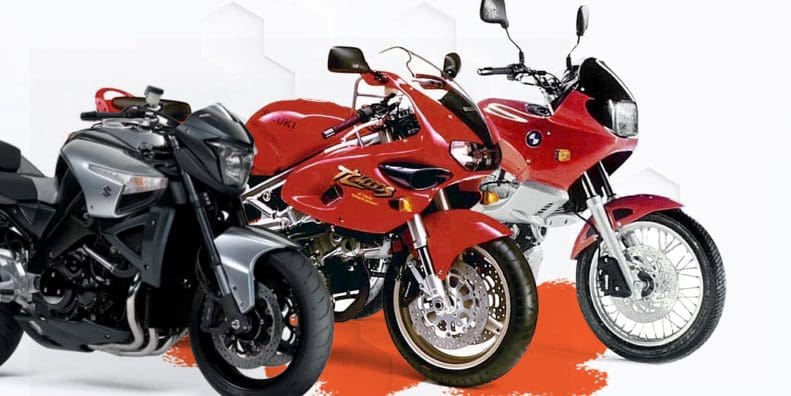The Fastest Street Motorcycles Ever Made [2024 Edition]
Updated October 10, 2023 by Simon Bertram
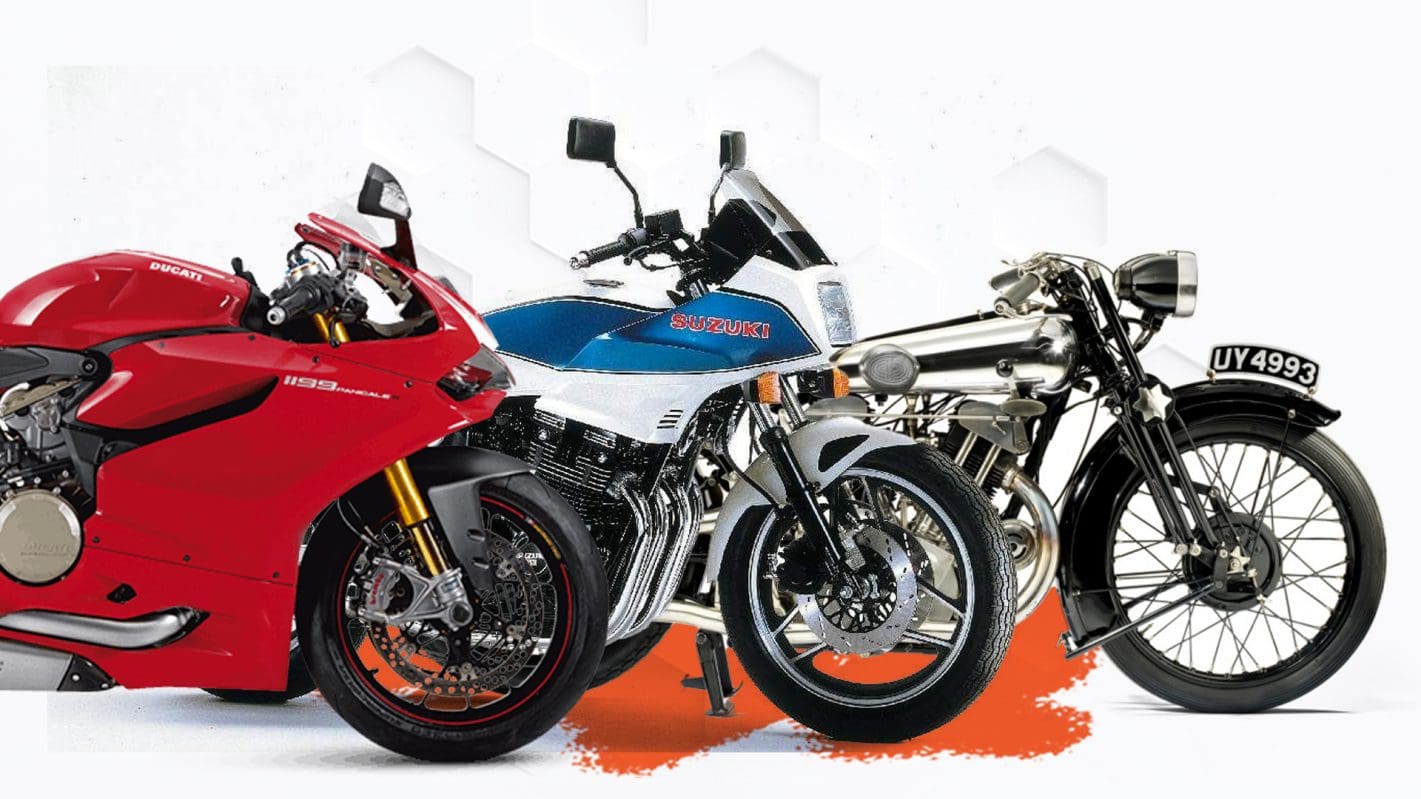
When Speed & Power Are The Only Things That Count
Article Quick Nav
These are the fastest motorcycles ever made:
From the moment humans figured out how to derive power from gasoline and build machines to move us about, we had one question: how fast is it?
Going fast, being fast, finding ways to get faster, this is how we measure superiority. For me when it comes to motorcycles, I divide fast into quickest A to B, and overall top speed. For this list, I chose to focus on major milestones on the quest for fast.
While there have been plenty of fast motorcycles, I will also further break this list down into the fastest of each major generation, those being pre-War, post-War, the Original Supersport Era of the 1980s, and the Modern Era post-1990.
Here, then, are the fastest motorcycles ever made!
About Our Selections
These selections are based on road legal motorcycles that are the fastest ever made. Some of the bikes selected are barely road legal, yes, but they are road legal in at least one jurisdiction in the world. Track only motorcycles were not considered, except for the one that currently holds the speed record and has yet to be challenged for it.
1925 Brough Superior SS100
The first bike to break through into triple digits on the speedometer
Why We Picked It:
During the 30 years preceding 1925, motorcycles year to year made steady engineering improvements.
George Brough pioneered the earliest British Supersport bikes with Brough Superior and the SS100. An accomplished racer and holder of World Records, he built the SS100 with a 45 hp (a crazy figure for the day) 988cc V-Twin and multiple outsourced components. Each bike was test ridden prior to delivery, certifying its ability to meet spec.
This test ride was done specifically because of the SS100's claim to fame, and the source of its nametag, the "Super Sport 100." And what is that claim? The SS100 is credited as the first production bike to achieve 100 mph.
Specifications:
Price: £170 in 1925 ($10,393 in 2023)
Engine: 988cc V-twin
Power: ~40 HP
Torque: Unknown
Transmission: 3 Speed Hand-Shift Manual
Curb Weight: ~340 lbs
Strengths:
The first motorcycle to reach triple digit speeds on the MPH scale
Incredibly rare, as only 69 were built. Can reach up to $400,000 or more at auction
Learn More:
1948 Vincent Black Lightning
The fastest bike in the post-War era that could reach an incredible 150 MPH!
Why We Picked It:
In 1948, Vincent Motorcycles had already matched the Brough Superior SS100 Pendine and its 110 mph speed record. Entering 1949, Vincent moved the bar in a big way..
Producing 70 hp from a strengthened 998 cc V-twin out of the Black Shadow, and stripping away as much weight as possible, the Black Lightning was handed to Rollie Free to send across the Bonneville Salt Flats.
After some positive test runs hitting 148 mph, I keep trying to imagine the conversation Rollie had with his team:
“Ok boys, the way I see it, if I strip down to my underwear and laid out like Superman I can get us the record!”
“Sounds good Rollie, let's do it!”
After a 2 way average of 150.313 mph his status as a Legend was made, and Vincent was the first manufacturer to hit 150 mph.
Specifications:
Price: £300 in 1948 ($10,960 in 2023)
Engine: 998cc V-twin
Power: 70 HP
Torque: Unknown
Transmission: 4 Speed Hand-Shift Manual
Curb Weight: 380 lbs
Strengths:
Although it required the rider to lie prone on top of the bike in nothing but his underwear, the Black Lightning was the first production motorcycle to hit 150 MPH
Extremely rare, as only 31 Black Lightning bikes were made before Vincent HRD ran into financial problems
Learn More:
1984 Suzuki GS1150ES (a.k.a. GSX1100ES)
The first Gixxer, and one of the fastest road legal bikes of the early 1980s
Why We Picked It:
In North America it was known as the GS1150ES; to the rest of the world, it is the GSX1100, and gave birth to the name that almost any Suzuki supersport is known by today: The Gixxer.
However, in 1984 (released as a 1985 model year bike), the GS1150ES was unlike anything that had come from Japan before. It has simultaneously been called the last "big standard" from Suzuki, as it had no fairings like standard bikes of the time, as well as the first major supersport from Japan, arriving just a few months prior to Kawasaki's first Ninja supersport.
At the time, however, it was the fastest ¼ mile bike tested by Cycle World. It would rocked down the drag strip in just under 11 seconds, and was going 120 MPH when it broke the timing beam. This is thanks to its 1,075cc inline four, which produced a fairly massive 111 HP for the 1980s. Its claim to fame lies also in the fact that if you tucked down behind the short windscreen and pinned it in 5th gear, it would tickle at 150 MPH, making it one of the fastest bikes of the original supersports era, although its dominance did not last long.
Specifications:
Price: $4,400 in 1984 ($13,030 in 2023)
Engine: 1,075cc inline four
Power: 111 HP
Torque: 70.9 lbs-ft
Transmission: 5 Speed Manual
Curb Weight: 564 lbs
Strengths:
The world's first true Gixxer, and fast as all hell to prove it.
The last supersport to carry that class title without fairings
Led directly to the creation of one of the most famous Suzuki bikes of all time, the Katana, in 1985
Learn More:
1984 Kawasaki Ninja GPZ900R
The bike that brought forth the Ninja moniker, and brought about one of the things that make sport bikes so fast: Full fairings
Why We Picked It:
After Suzuki's short domination of the supersports speed title, Kawasaki released quite possibly one of the most important bikes of their entire history, the 1984 Ninja GPZ900R. Called either a Ninja 900 or ZX900A depending on where in the world you lived, this was a powerhouse motorcycle that shaped the future of supersport bikes the world over.
Carrying a 908cc inline four, it made 115 HP at the crank and, thanks to a very slick 6 speed transmission, had one of the lowest rates of parasitic loss of any motorcycle, resulting in 100+ HP at the rear wheel. It was so fast, so brutally quick in acceleration, that it set records for initial release year sales.
What made it so exceptional was the fact that it used the engine as a stressed member of the frame, but then paid attention to the aerodynamics of the bike and added fairings across the sides of the engine, starting the trend for sport bikes that continues to this day.
When Cycle World, the biggest motorcycle magazine in the 1980s, got their hands on one, it tested into the 10’s with a 10.94-sec pass. “I feel the need, the need for speed”, Mavericks life motto from a little movie called Top Gun. Of course, he had to ride a GPZ900R (Ninja 900), the first production bike to exceed 150 mph. The power of the bike pushed the venerable little Ninja 900 to 151 mph.
Specifications:
Price: $3,999 in 1984 ($11,845 in 2023)
Engine: 908cc inline four
Power: 115 HP
Torque: 63 lbs-ft
Transmission: 6 Speed Manual
Curb Weight: 508 lbs
Strengths:
The first supersport to go beyond 150 MPH
Introduced the idea of a fully faired supersport as a main production bike. Some bikes before had played around with partial fairings, including Suzuki's GS bikes, but the GPZ900R was the first to have every bike fully faired
Extremely popular and sold very well, very likely because of its short but significant appearance in Top Gun
Learn More:
1990 Kawasaki Ninja ZX-11 (a.k.a. ZZ-R1100)
The first superbike of the modern era to reach 170 MPH
Why We Picked It:
Kawasaki and the legendary ZX-11 ruled the first half of the ‘90s. It is not so much a claim as simply a statement of fact. When it released in 1990, it beat out absolutely every other manufacturer with a top speed that was limited only by the redline in 6th gear of 176 MPH.
Unknown to Kawasaki at the time, the ZX-11 was a gigantic gauntlet thrown down for other manufacturers of sport bikes the world over to make something that could beat it. It proved to be a difficult task as the ZX-11 brought forth a ton of new innovations for superbikes. It was the first to use a ram air induction system, for example. It continued Kawasaki's amazing transmission engineering as well, with a record-setting parasitic loss of only 7.4% total power.
It also had a very cleverly designed engine, and even at 1,052cc it produced a fairly astonishing 145 HP, which was the most powerful inline four engine for its displacement at the time. It also had a body that had been shaped and refined in a wind tunnel, and the result was a very slippery, very powerful superbike that accelerated like crazy and was, in the words of a few reviewers, "almost unbelievably fast."
Specifications:
Price: $7,599 in 1990 ($17,895 in 2023)
Engine: 1,052cc inline four
Power: 145 HP
Torque: 78.8 lbs-ft
Transmission: 6 Speed Manual
Curb Weight: 603 lbs
Strengths:
Introduced the ram-air induction system for motorcycles, an idea that was copied by names such as Ducati, Honda, and even Harley-Davidson for their Sportster bikes
Had one of the best designed and well engineered transmissions of its day, losing on 7.4% of power, meaning the bike was producing 134.5 HP at the rear wheel!
At the top of 6th gear, bouncing off the redline, the bike was capable of 176 MPH
Learn More:
1996 Honda CBR1100XX Super Blackbird
The bike that launched the Power Wars in the second half of the 1990s
Why We Picked It:
Throughout the first half of the 1990s, many manufacturers tried to reach the lofty bar that Kawasaki had set. While the ZX-11 could reach 176 MPH with the North American version, it was slightly limited in many other regions to "just" 170 MPH, and that was the goal that every manufacturer set their sights on.
Honda, however, were the ones that planted their flag in challenge, and was the first manufacturer to beat Kawasaki at the speed game. This came about with their designed-for-nothing-but-power-and-speed CBR1100XX Super Blackbird. The name was inspired by the SR-71 Blackbird, the fastest manned, regular-flight aircraft during its service as a Mach 3+ spy plane.
It is an appropriate name too, as the CBR1100XX was designed and engineered in Honda's skunkworks program. Only the best of the best worked on it, and the result was a superbike with a 1,137cc inline four that produced a mind boggling 164 HP!! Add to that a body that was sleeker and slipperier than anything that Honda had made before, and then give it enough torque to reverse the spin of the Earth...um yeah, that will work. New record? 177 mph.
Honda did not realize it at the time, but they had just fired the first salvo in what would come to be known as the Power Wars, a period of 4 years from 1996 to 2000. The Wars saw manufacturers pushing the extreme limits of what you could shoehorn into an engine, how slippery you could make a bike, and how fast you could accelerate and top out at.
Specifications:
Price: $10,999 in 1996 ($21,575 in 2023)
Engine: 1,137cc inline four
Power: 164 HP
Torque: 93 lbs-ft
Transmission: 6 Speed Manual
Curb Weight: 556 lbs
Strengths:
Beat the Kawasaki ZX-11's unofficial top speed by 1 MPH, and its official top speed by 7 MPH
One of the most powerful bikes Honda ever built, only behind the CBR1000RR-R, RC213V-S, and VFR1200F
Unlike the ZX-11, it was not restricted by region, so every region had a bike that could reach 177 MPH, the speed record that stood for almost 3 years
Was the first salvo of the Power Wars of the second half of the 1990s, and is still one of the fastest accelerating motorcycles of all time, even compared to modern superbikes
Learn More:
1999 Suzuki GSX-1300R Hayabusa
Started by Honda, ended by Suzuki. The bike that decimated all others and won the Power Wars
Why We Picked It:
Hayabusa is Japanese for “Peregrine Falcon”. A Falcon is known for its speed, and its diet of “blackbirds.” Oh Suzuki, I see what you did there.
Using its full title, the GSX-1300R Hayabusa was originally going to be just a regular Gixxer with an oversized engine in it. However, what the Super Blackbird showed Suzuki was that aerodynamics played a major part in top speed, especially regarding stability. So, while the engine was pretty much ready, the entire frame and body of the Hayabusa was remade with a lot of wind tunnel and computer aided design to make the bike the most aerodynamic it could be, even at the expense of aesthetics.
The result, when unveiled in 1999, was a very polarizing bike. On one hand, it put a serious challenge down to the top speed record held by Honda, but on the other hand, to many, it was unbelievably ugly. However, many of those that were saying that snapped their mouths closed when the first high-speed runs were published by motorcycle magazines the world over.
A 1,299cc monster. A power record of the time at 174 HP. A windscreen and body designed to be tucked down tight over. A body designed to slice the air, not bully it out of the way. The result: A speed record of 194 MPH for the 1999 and 2000 bikes, before the European-Japanese agreement to limit top speeds to "only" 186 MPH.
The Hayabusa set and/or broke so many records that it effectively ended the Power Wars. That is how important and legendary this bike was. No one wanted to, or could, match it before the new Euro 3 emissions regulations effectively ended any further attempts.
Specifications:
Price: $10,499 in 1999 ($19,396 in 2023)
Engine: 1,299cc inline four
Power: 174 HP
Torque: 99.6 lbs-ft
Transmission: 6 Speed Manual
Curb Weight: 551 lbs
Strengths:
The fastest superbike of the 20th century
Still holds the road-legal speed record of 194 MPH before the agreement among governments and manufacturers to limit a road legal superbike to 186 MPH
Is currently on its third generation, with a fully restyled body and reworked frame that make it look a lot better than the hyper-organic first and second generations that many called ugly
At the time of its released, it effectively ended the Power Wars and still sits on the throne as the victor of the fastest road-legal superbike. Yes, there are track bikes that can easily outpace it, but the Hayabusa was designed for the street first and foremost
Learn More:
2008 MV Agusta F4 R 312
The first superbike to come close to 200 MPH with a sub-1,000cc engine capacity
Why We Picked It:
Like watching Italians play Briscola, and passionately slamming down the winning card, this was MV Agusta and the 2008 F4 R 312. The Italians didn’t care about the Japanese and their “Gentleman's Agreement”, they build bikes engineered with one goal: being fast... crazy fast!
183 hp and a dry weight of 423lbs, is a perfect recipe for fast. It was the last mainstream model of the first generation F4 bikes from MV Agusta, and was built up from the F4 1000 R, which carried at 998cc inline four, although the one in that bike produced "only" 174 HP.
Despite being a relatively slippery bike in terms of aerodynamics, it still couldn't quite crack the 200 MPH barrier. But, as it says in the name, it got pretty damned close at312 km/h (194 mph). Hence, the F4 R 312!
Specifications:
Price: $24,995 in 2008 ($35,730 in 2023)
Engine: 998cc inline four
Power: 183 HP
Torque: 84.8 lbs-ft
Transmission: 6 Speed Manual
Curb Weight: ~450 lbs
Strengths:
The fastest sub-1,000cc superbike so far in motorcycle history at 194 MPH
A rare, low production motorcycle that will fetch upwards of $60,000 at auction or private sale today, if not more.
Learn More:
2013 Ducati 1199 Panigale R
A superbike that was barely road legal to start with, but in full non road legal track spec smashed the 10 second quarter mile and the 200 MPH barrier
Why We Picked It:
In 2013 Ducati, in keeping with awesome Italian swagger, decided they might as well smash all barriers. Here you go public, have this amazing World Superbike on street tires. The 1199 Panigale R, with the “track only” exhaust, made 202 hp. I’m sorry, how much?? 202, and Ducati with a mix of magical alloys reduced weight to 364 lbs.
With the regular "street" exhaust, it was still a monster of speed, as it developed over 190 HP and would still tickle at the middle of 180 MPH. In fact, it was more the aerodynamic drag of the license plate holder and the mirrors on the street version that caused it to only hit 184 MPH, and with both removed, it was capable of 190+ MPH in "street" trim.
Yet, because of the R in the name, if you fitted the track parts but kept the mirrors and license plate holder, you were barely road legal, but it still counted! In full track trim, however, this bike delivered high 9 second ¼ mile times, and brought production motorcycles past the 200 mph mark, at 202 mph.
Specifications:
Price: $30,995 in 2013 ($40,950 in 2023)
Engine: 1,198cc L-twin
Power: 202 HP
Torque: 100 lbs-ft
Transmission: 6 Speed Manual
Curb Weight: 364 lbs
Strengths:
The first production superbike to break 200 MPH at the same time as breaking the 10 second quarter mile mark.
Had a variety of trim options, from full street, to partial race parts, to full track-only, and any combination therein. With the track only engine internals and exhaust, but the street spec mirrors and plate holder, it still counted as road legal in parts of the EU, and could hit 202 MPH.
Learn More:
2021 Kawasaki Ninja ZX-14R
The superbike that has no racing parts included, and with a small ECU reprogram can reach 200 MPH
Why We Picked It:
Released initially in 2012, the Kawasaki ZX-14R, at least before the H2R, was Kawasaki’s speed king. Boasting a 1,441cc inline-four, the bike is electronically limited by the Gentleman’s Agreement to a top speed of 186 MPH. For those unaware of that agreement, it was one of many among Japanese manufacturers throughout the decades to limit power and speed in the pursuit of fairness and safety.
One of the most famous of those agreements was in the automotive sector in the early 1990s that limited Japanese sports cars to 280 HP. However, this was the era of the Toyota Mark IV Supra, the Nissan Skyline GT-R32, and the Mazda RX-7 FD, and it was a very loose agreement, as all three cars could easily reach over 1,000 HP with some mild modification and tuning, and all were capable of over 400 HP on stock parts.
The same is true for the ZX-14R, as for those with access to an ECU unlocker and a little bit of programming knowledge, the governor could be lifted, although it only adds about 8 more MPH before hitting the rev limiter in 6th gear. Still, with a little electronic wizardry and the willingness to void any warranty by raising the fuel-cutoff soft limiter to the hard limiter rev range, 200 MPH is achievable on a flat track in perfect conditions, and that’s plenty fast enough!
Specifications:
Price: $16,599
Engine: 1,441cc inline four
Power: 208 HP
Torque: 113 lbs-ft
Transmission: 6 Speed Manual
Curb Weight: 593 lbs
Strengths:
The fastest Kawasaki Ninja before the H2 supercharged bike models were released
Limited to 186 MPH as per a Gentleman's Agreement, but with an ECU flash and mild retune, can hit 192 MPH, and if you don't care about the warranty and lift the soft limiter, it can his 200 MPH.
Learn More:
Honorable Mention: 2015 Kawasaki Ninja H2R
A track only motorcycle that has set, and still holds, the world record as the fastest motorcycle ever
Why We Picked It:
Kawasaki could never stay away - the top speed is in their brand DNA. Now I get this bike is a very limited machine, not at all normal production, but fast is fast no matter how you look at it.
In 2015 Kawasaki unveiled the Ninja H2R. Showcasing the pinnacle of what the manufacturer was capable of, the supercharged literbike with black chrome paint delivers 310 HP. 310 HP from 998cc's in bordering on insanity, but then again, looking at the picture above, the H2R screams insane from every angle!
It is so extreme, so out there, that it even looks like it's going 200 mph on its kickstand, it has been taken to over 200 MPH by many lucky owners. However, Kawasaki needed to prove that it was the fastest thing on two wheels that didn't have a jet turbine of a fully encased aerodynamic shell, so in 2016, across the Osman Gazi Bridge in Turkey, the proved it.
Ridden by retired professional racer Kenan Sofuoglu, starting from a dead stop, the H2R accelerated to a mind boggling 250 MPH (400 KPH) in just 26 seconds. It is the first superbike, first motorcycle even, that has broken through to 250 MPH on regular pavement, and still holds the record to this day. While it's not a road legal motorcycle, it simply needed to be on this list as it is, as of right now, the fastest motorcycle ever made.
Specifications:
Price: $58,100
Engine: 998cc supercharged inline four
Power: 310 HP
Torque: 115 lbs-ft
Transmission: 6 Speed Manual
Curb Weight: 476 lbs
Strengths:
The first, and so far only, "regular" superbike that has achieved 250 MPH, or 400 KPH. This is almost as fast as a Bugatti Veyron hypercar (254 MPH)
Track-only, as it has to be aerodynamically shaped, use winglets at the front, and use racing slick tires to transfer the 310 HP to the ground without immediately looping as you pound up the gears
One of the most spectacular engineering achievements in recent years in the realm of motorcycles.
Learn More:
Other Best Motorcycle Lists


